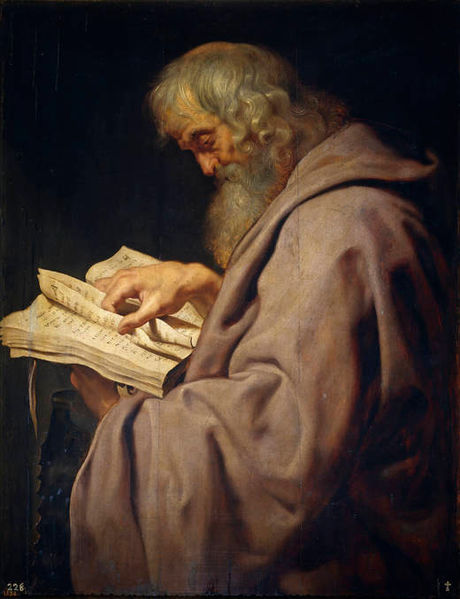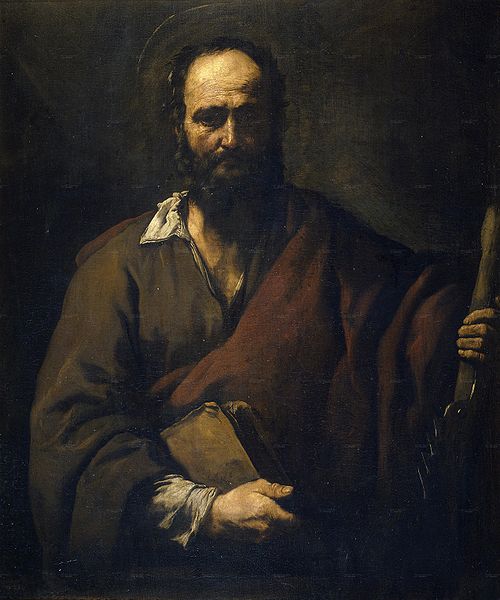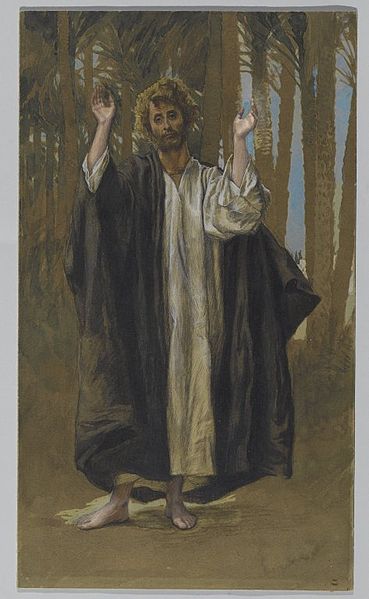<Back to Index>
- Apostle Simon the Zealot, 1st
Century
PAGE SPONSOR



The apostle called Simon Zelotes, Simon the Zealot, in Luke 6:15 and Acts 1:13; and Simon Kananaios or Simon Cananeus ("Simon" signifying שמעון "hearkening; listening", Standard Hebrew Šimʿon, Tiberian Hebrew Šimʿôn), was one of the most obscure among the apostles of Jesus. Little is recorded of him aside from his name. A few pseudepigraphical writings were connected to him, and Jerome does not include him in De viris illustribus.
The name of Simon occurs in all of the synoptic gospels and Acts that give a list of apostles, without further details:
Simon, whom he named Peter, and Andrew his brother, and James and John, and Philip, and Bartholomew, and Matthew, and Thomas, and James the son of Alphaeus, and Simon who was called the Zealot, and Judas ["the son" is interpolated] of James, and Judas Iscariot, who became a traitor—Luke 6:14-16, RSV
To distinguish him from Simon Peter, he is called Kananaios, or Kananites (Matthew 10:4; Mark 3:18), and in the list of apostles in Luke 6:15, repeated in Acts 1:13, Zelotes, the "Zealot". Both titles derive from the Hebrew word qana, meaning The Zealous, though Jerome and others mistook the word to signify the apostle was from the town of Cana, in which case his epithet would have been "Kanaios" or even from the region of Canaan. As such, the translation of the word as "the Cananite" or "the Canaanite" is traditional and without contemporary extra - canonic parallel.
Robert Eisenman has pointed out contemporary talmudic references to Zealots as kanna'im "but not really as a group — rather as avenging priests in the Temple". Eisenman's broader conclusions, that the zealot element in the original apostle group was disguised and overwritten to make it support the assimilative Pauline Christianity of the Gentiles is more controversial. John P. Meier points out that the term "Zealot" is a mis - translation and in the context of the Gospels means "zealous" or "jealous" as the Zealot movement did not exist until 30 to 40 years after the events of the Gospels.
In the Gospels, Simon the Zealot is never identified with Simon the brother of Jesus mentioned in Gospel of Mark 6:3 :
Isn't this the carpenter? Isn't this Mary's son and the brother of James, Joseph, Judas and Simon? Aren't his sisters here with us? — New International Version
The Catholic Encyclopedia suggests that Simon the Zealot may be the same person as Simeon of Jerusalem or Simon the brother of Jesus. He could perhaps be the cousin of Jesus or a son of Joseph from a previous marriage.
The Eastern Orthodox Church tradition holds that it was Simon's wedding that Christ and his disciples attended in Cana of Galilee in which Christ turned water in six stone jars to wine. He is called zealot because in seeing this miracle, Simon left his home, his parents and his bride and followed Christ. It is also said that after Pentecost, his mission was in a place called Mauretania in Africa.
Another tradition holds that this is the Simeon of
Jerusalem who became the second bishop of Jerusalem,
although he was born in Galilee.
St. Isidore of Seville drew together the accumulated anecdotes of St. Simon in De Vita et Morte; the fully developed aura of legend is presented in the Legenda Aurea (ca 1260).
In later tradition, Simon is often associated with St. Jude as an evangelizing team; they share their feast day on 28 October. The most widespread tradition is that after evangelizing in Egypt, Simon joined Jude in Persia and Armenia or Beirut, Lebanon, where both were martyred in 65 AD. This version is the one found in the Golden Legend. He may have suffered crucifixion as the Bishop of Jerusalem.
One tradition states that he traveled in the Middle East and Africa. Christian Ethiopians claim that he was crucified in Samaria, while Justus Lipsius writes that he was sawn in half at Suanir, Persia. However, Moses of Chorene writes that he was martyred at Weriosphora in Caucasian Iberia. Tradition also claims he died peacefully at Edessa. Another tradition says he visited Britain — possibly Glastonbury — and was martyred in Caistor, modern day Lincolnshire. Another, doubtless inspired by his title "the Zealot", states that he was involved in a Jewish revolt against the Romans, which was brutally suppressed.
The 2nd century Epistle of the Apostles (Epistula Apostolorum), a polemic against gnostics, lists him among the apostles purported to be writing the letter (who include Thomas) as Judas Zelotes and certain Old Latin translations of the Gospel of Matthew substitute "Judas the Zealot" for Thaddeus / Lebbaeus in Matthew 10:3. To some readers, this suggests that he may be identical with the "Judas not Iscariot" mentioned in John 14:22: "Judas saith unto him, not Iscariot, Our Lord, how is it that thou wilt manifest thyself unto us, and not unto the world?" As it has been suggested that Jude is identical with the apostle Thomas (see Jude Thomas), an identification of "Simon Zelotes" with Thomas is also possible. Barbara Thiering identified Simon Zelotes with Simon Magus, however this view has received no serious acceptance. The New Testament records nothing more of Simon, aside from this multitude of possible but unlikely pseudonyms. He is buried in the same tomb as St. Jude Thaddeus, in the left transept of the St. Peter's Basilica in Rome, under the altar of St. Joseph.
In art, Simon has the identifying attribute of a saw because according to legend, he was put to death by a saw.
St. Simon, like the other Apostles, is regarded as a
saint by the Roman Catholic
Church, the Eastern
Orthodox Churches, the Oriental
Orthodox Churches, the Eastern Catholic Churches,
the Anglican Church and
the Lutheran Church.
Muslims accept Jesus as a prophet of Islam. The Qur'an also speaks of Jesus's disciples but does not mention their names, instead referring to them as "helpers to the work of God". Muslim exegesis and Qur'an commentary, however, names them and includes Simon among the disciples. Muslim tradition says that Simon was sent to preach the faith of God to the Berbers, outside North Africa.